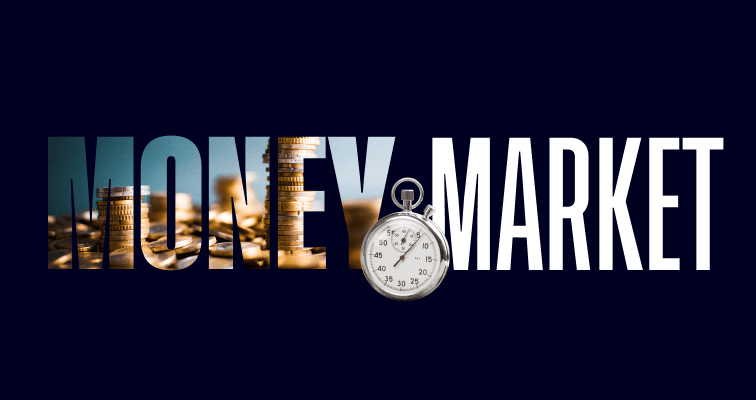Money markets and capital markets perform similar, but not identical, functions. Understanding the differences between the two can help investors to make decisions that might help them achieve their personal investment objectives. Learn what money markets and capital markets are, how they work and how to invest in them.
The financial markets were developed, in part, to connect investors with spare capital to firms looking to fund business opportunities. The potential rate of return, the duration of the “loan” and the exact instrument used to record the transaction, vary according to each individual situation.
There are many forms that the process can take, but there are two widely used terms that differentiate between types of investing: money markets and capital markets.
What is the money market?
The term “money market” refers to short-term, lower risk cash transfers. These transfers are carried out by trades being booked in short-term debt instruments — where one party pays cash to own a securitised asset. The money market encompasses deals that last anywhere between one day and twelve months.
What is short-term debt?
Any liability that is due to be paid back in less than twelve months is considered short-term debt. The instruments used in the money market include:
- Money market funds
- Certificates of deposit (CDs)
- Repurchase agreements (Repos)
- Treasury Bills (T-Bill)
- Commercial papers
- Currency swaps
- Short-term bank & central bank loans and financing

Who uses the money market?
Most short-term debt trading is carried out by large institutions, such as governments, banks and corporations. They might be looking to earn a return on excess cash they have, or they could be looking to borrow to ease short-term liquidity issues.
Tip: Money market transactions can be used to meet short-term cash flow needs, as much as they are used to make financial returns.
How can investors use the money market?
Historically, retail investors have neglected the money market because rates are usually only marginally higher than those offered by high street savings accounts. Those looking to optimise returns and improve the margin of return on cash balances can attempt to do so using the following money market instruments.
- Money market funds
- Mutual funds
- Municipal funds
- Bonds
- Certificates of deposit
- Money market accounts
“The best way to measure your investing success is not by whether you’re beating the market but by whether you’ve put in place a financial plan and a behavioural discipline that are likely to get you where you want to go.”
Benjamin Graham
Money markets could be a good potential option for investors who want to lower the overall level of risk on a portfolio.
Monitoring money markets can also help investors to identify pressure points in the financial system. If liquidity dries up, or money market interest rates move to indicate that borrowers and lenders are more fearful of counterparty credit risk, this can signal the potential start of an economic downturn. This would then have repercussions on the price of other asset classes.

What is the capital market?
The capital markets involve the buying and selling of financial assets across a broad spectrum of markets. Instruments traded include stocks and long-term bonds, ETFs, currencies and cryptoassets.
What is long-term debt?
Long-term debt instruments include bonds, direct loans and equity-backed assets. The defining feature of these instruments is that the agreement between borrowers and investors is expected to last longer than twelve months. The price can be increased within a shorter time frame, but many investors in the capital market take a buy-and-hold approach.
Tip: The money market and capital market perform the same function — they connect investors (with spare cash) with organisations that want to borrow.
Who uses the capital market?
Retail and institutional investors enter the capital markets in the hope of making capital returns. On the other side of the deal, corporations, banks and governments use the capital markets to try and raise funds to finance medium- and long-term projects.
Tip: Using a demo account is a good way to practise trading asset classes that you haven’t traded before.
How can investors use the capital market?
There are a wide range of asset groups available to those looking to gain exposure to the capital markets, and trading in them can be carried out using desktop or handheld devices. Opening an account with an online broker takes minutes to do, and most platforms are designed to be user-friendly, with low fees and commissions.
Buying an asset on the capital markets provides investors with an opportunity to generate regular income streams or capital gains. However, a return is not guaranteed, and risk-return must be considered.
Tip: While money markets and capital markets perform the same function, the risk profile of the instruments involved, and the investment time horizon of the deals carried out, can vary widely.

Money market vs capital market
There is some crossover between the money market and the capital market, which is understandable as they both share the same aim: to provide a means for capital to be transferred from investors to businesses.
Capital markets tend to be less liquid, and investments can be longer-term in nature. However, this is counterbalanced by potential returns being greater. Retail investors will also have an easier time accessing the capital markets. This is due to brokers setting up platforms that offer markets in stocks, bonds, forex, indices, ETFs and cryptoassets.
| Money Market | Capital Market |
|---|---|
| Investments with maturity dates of less than twelve months (short-term debt) | Investments with maturity dates of more than twelve months (long-term debt) |
| Instruments can include money market funds, mutual funds, municipal funds, bonds, certificates of deposit and money market accounts. | Instruments can include stocks and shares, bonds, debentures, equities, cryptocurrencies and ETFs. |
| Participants can include governments, commercial banks, investment banks, hedge funds, the “repo” market and central banks. | Participants can include governments, stockbrokers, investment banks, commercial banks, mutual funds, hedge funds, institutional and retail investors. |
| Less formal in nature, a lot of transactions are “off exchange” and arranged between the parties involved. | More formal, and the instruments used can be regulated and traded on exchanges. |
| Low risk-return | Medium to high risk-return |
Final thoughts
Most retail investors are drawn to the capital market, rather than the money market, because there is greater potential upside, although there are risks attached to both. Studying and investing in the money market can still be a good option for some investors. It’s a slightly lower-risk option for generating a return, and events in the money market often spill over into the capital markets and influence the price of other assets in a portfolio.
Visit the eToro Academy to learn more about the money market and capital market.
FAQs
- Why do money market rates vary?
-
A country’s base interest rate is one of the key factors regarding money market rates. Money market rates don’t tend to diverge too far from that base rate, but will factor in the creditworthiness of the borrower and geopolitical risk. The higher the risk, the higher the interest rate.
- What are primary and secondary markets?
-
Investors and firms deal directly with one another in a primary market. For example, in an Initial Public Offering (IPO), a firm might sell its own shares to investors. In a secondary market, investors trade the assets between themselves. Retail investors trading shares that are already listed is an example of a secondary market.
- Why are capital markets important for investors?
-
Studying different areas of the capital market can help investors to pick up on trends and trading opportunities. For example, inverted bond yields in the fixed income market are historically seen as a sign that equity markets might be due for a price correction.
This information is for educational purposes only and should not be taken as investment advice, personal recommendation, or an offer of, or solicitation to, buy or sell any financial instruments.
This material has been prepared without regard to any particular investment objectives or financial situation and has not been prepared in accordance with the legal and regulatory requirements to promote independent research. Not all of the financial instruments and services referred to are offered by eToro and any references to past performance of a financial instrument, index, or a packaged investment product are not, and should not be taken as, a reliable indicator of future results.
eToro makes no representation and assumes no liability as to the accuracy or completeness of the content of this guide. Make sure you understand the risks involved in trading before committing any capital. Never risk more than you are prepared to lose.


